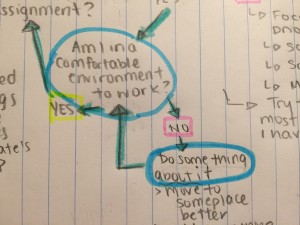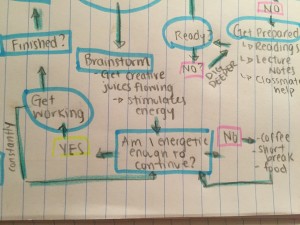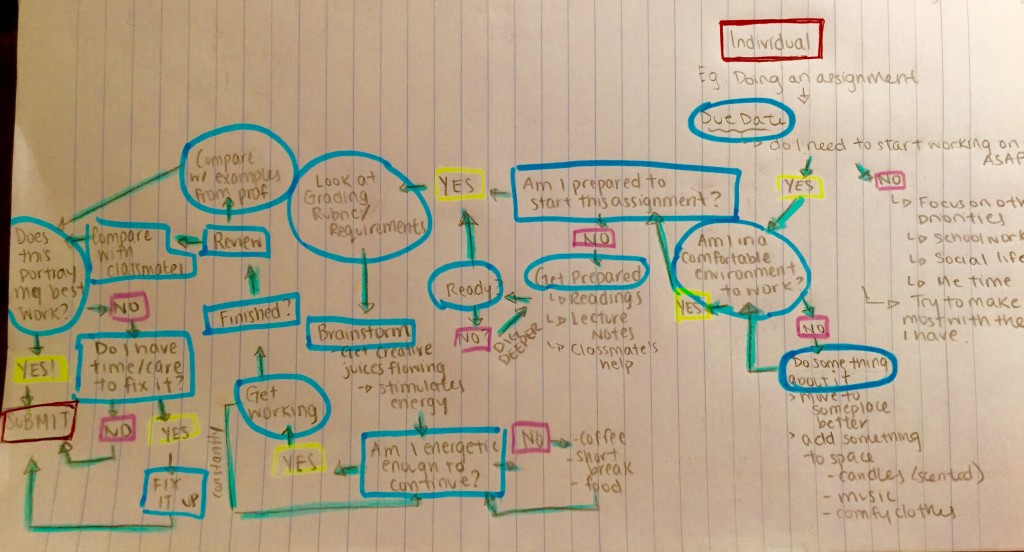What is my Problem?
When it comes to solving a problem I begin to go through the process starting with one big question: “What kind of problem am I dealing with?” Normally, it separates into two segments. The first of these segments is a personal, more social type of problem, branching out into topics such as family, friends, and romance. The next would be individual based, revolving around school or work and solely myself and my own actions. For this assignment specifically, my focus will be towards my thought process behind an individual problem, such as working on an assignment. Based off of “The 10 Faces of Innovation,” (1) the two faces that appeared to agree with who I was as a person would be “The Experience Architect.” As I worked through the step-by-step process of finishing an assignment, I noted how relevant the simplicities of everyday actions caused me to work a certain way, and the importance of these actions.
For this assignment specifically, my focus will be towards my thought process behind an individual problem, such as working on an assignment. Based off of “The 10 Faces of Innovation,” (1) the two faces that appeared to agree with who I was as a person would be “The Experience Architect.” As I worked through the step-by-step process of finishing an assignment, I noted how relevant the simplicities of everyday actions caused me to work a certain way, and the importance of these actions.
We begin with the due date. Quite frankly, if the due date is not anytime within the next week or couple of days, there is no adrenaline rush to encourage me to start the assignment. Rather, I would turn my attention to other priorities, such as other school work or my social life. I tend to make the most out of whatever time I have given to me, which requires some excitement or urgency for me to start something. However, if the due date is upcoming quickly – the rush is there, and I would analyze my comfort level. This comfort level is revolved around my senses. “Am I comfortable in this chair? Are the surrounding sounds pleasant or distracting? These jeans are too tight, sweat pants will be comfier.” I realized, that the simplicities of putting on music or having some fruity tea goes farther than merely preparing myself, but rather ties into “The Experience Architect” in me (2). This trait is crucial as it forces me to make any situation, even with the most dull homework, as enjoyable as possible. Without this level of satisfaction, I find it quite difficult to work through an assignment to the best of my abilities. 
Afterwards the real work begins. I begin to asses whether I feel prepared to start working on the assignment. This preparation includes readings, lecture notes, or the help of a classmate. Personally, if I feel clueless on something, it causes a hurt to my motivation. Once prepared, I must fully understand what is expected or desired from me. In this case, the simple reflection upon the grading rubric or requirements allow me to feel confident to begin. Brainstorming then allows creativity to spur, also stimulating energy and motivating me to finish the project. Constantly during the work process, I will stop and subconsciously check in to see if I am energized enough to continue. Like a phone, I need to recharge often since brain power drains energy quickly. Elements such as coffee, food, or a short break take place often during the thought process of finishing an assignment, allowing me to constantly get myself excited to continue the task. 
Once finished, a review takes place, whether with past course examples or with classmates. “Is my assignment unique enough? Is it meeting expectations?” Similar to the canvas in “Value Proposition Design,” my customer is my professor (3). Checking the rubric before starting allowed me to create value like a costumer profile based off of what the professor finds excellent (gain) or merely minimal (pain). When finishing the assignment, reviewing and comparing allows me to reflect on if my product reaches the “gain creators” and “pain relievers,” validating whether or not I reached the intended expectations. With the assignment now submitted, I tend to reward myself with something to go full circle in the enjoyment of the experience.
(3) Osterwalder, A., & Pigneur, Y. (2014). Canvas: Customer Profile. In Value proposition design: How to create products and services customers want. New Jersey: John Wiley & Sons.

